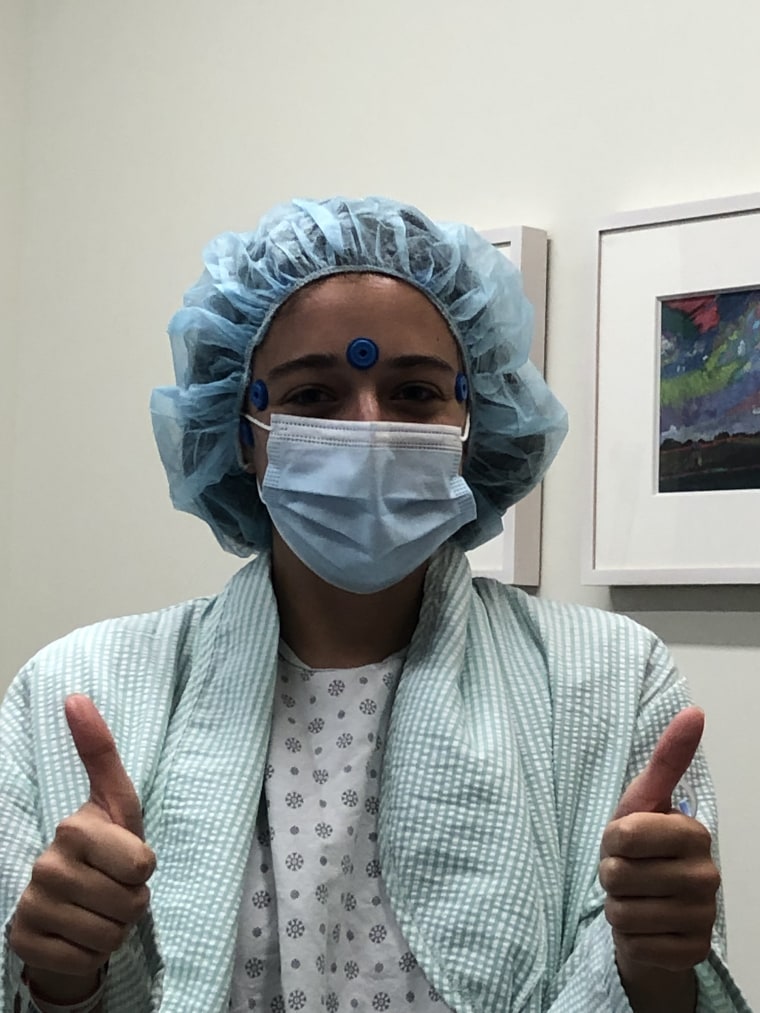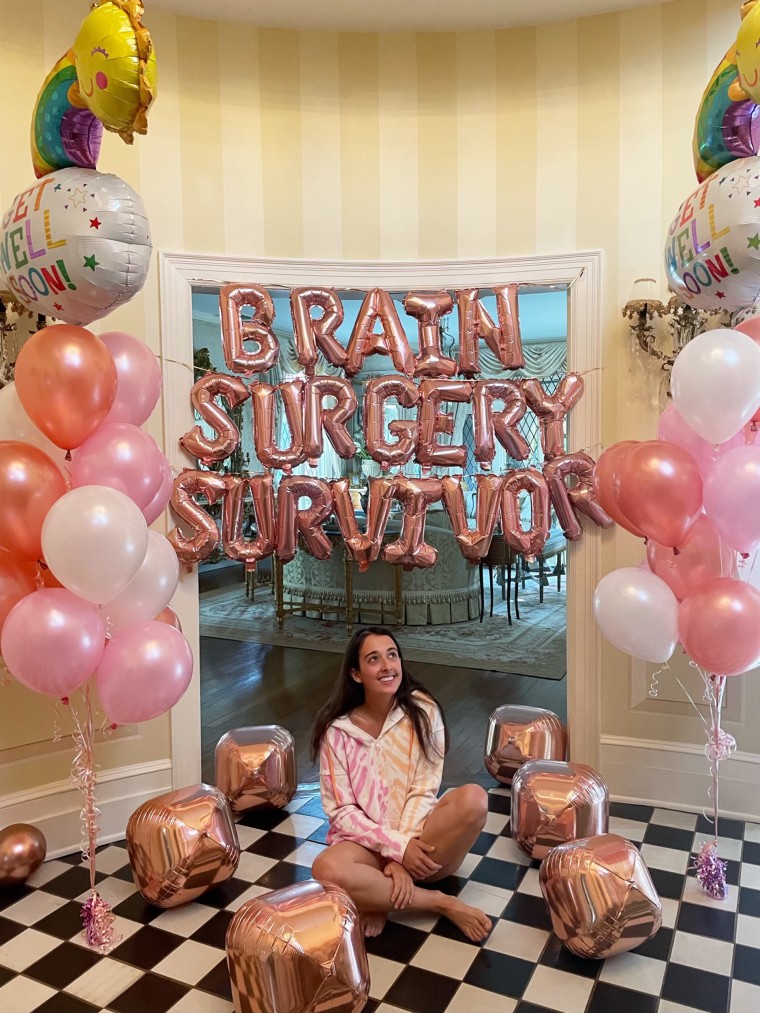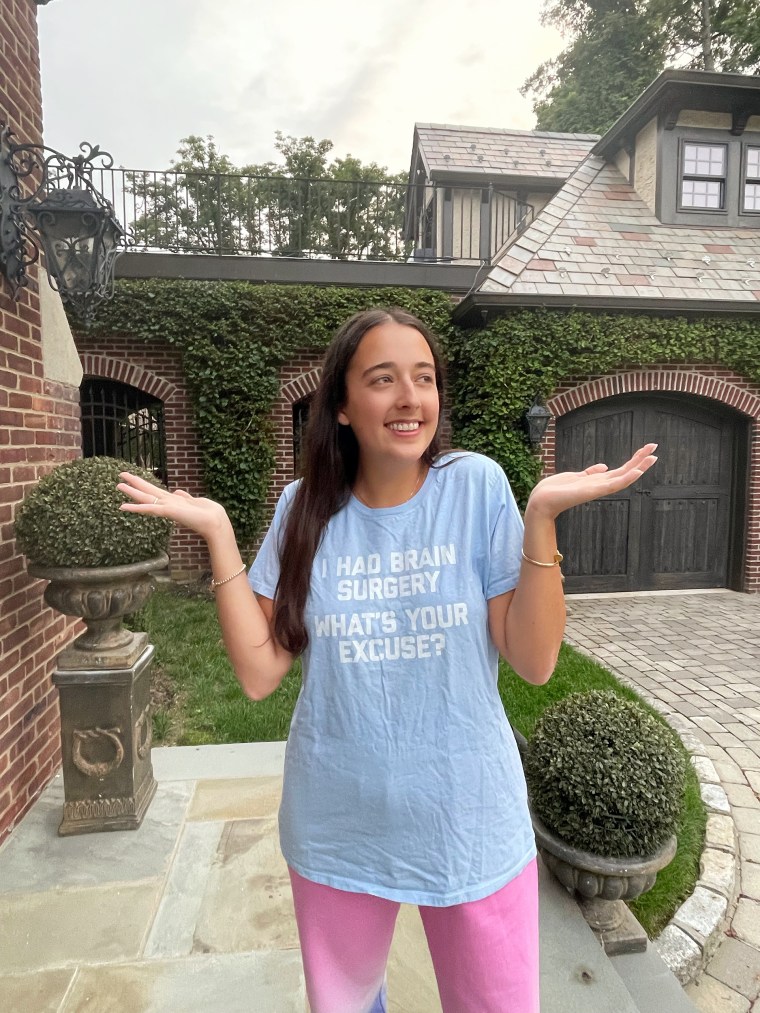When Danielle Soviero woke one morning in October 2020, the entire right side of her body felt numb. At first, she thought she had a pinched nerve. Days later, she started dropping things and her speech became slurred. She underwent an MRI and her doctor noticed she had a benign brain tumor that was bleeding.
“I’m freaking out. I’m 24 years old and you hear the word … ‘brain tumor,’” Soviero, now 25, of Long Island told TODAY. “Every single day I was worried that this tumor in my brain was going to bleed.”
Her doctor told her he wasn’t “terribly worried” and urged her to live life as “normal.” As her symptoms increased, she sought another opinion. This summer, she underwent surgery to remove the tumor.
“If I would have continued to do what my initial doctor said and lived a normal life and God forbid this tumor had a bleed at that size, it could have been deadly,” she said.

That’s why she hopes her story encourages other to seek treatment when something seems off.
“If anything is bothering you, you’re probably right and you should get it checked out,” Soviero said.
Looking for answers
After months of headaches, numbness and slurred speech, Soviero visited a neurologist who ordered an MRI. When the doctor called her at 8 p.m. on a Friday, she knew it was serious.
“They have found a benign tumor called a cavernous angioma in my brain on my left side, which is why I was having symptoms on the right side,” she explained. “Mine had actually hemorrhaged so because of the blood that was pooling in my brain, that’s why I was experiencing all those neurological symptoms.”
A cavernous angioma is a vascular malformation that forms in the brain. Treatment for it varies from observation to surgery depending on the symptoms, according to the National Organization for Rare Disorders.
Even though the doctor said the tumor was benign, Soviero worried.
“I was just in a full panic mode every single day,” she said.

Then in April 2021, she experienced “the worst migraine.”
“I’ve gotten my fair share of migraines throughout my life,” she said. “This one literally had me lying in bed thinking I was going to die. It was excruciating pain.”
Struck with such severe pain, she texted her doctor who recommended she take acetaminophen.
“I probably should have gone to the hospital but at the time you’re not focused on that,” she said. “I’m focusing on getting this headache to go away.”
For the next two weeks, Soviero felt “strange pressure” in her head.
“When I would go from sitting to standing I would actually physically hold my head because it felt like my brain was almost moving,” she said. “I called my doctor and I was like, ‘Something is wrong. I need another MRI. I’m not going to take ‘no’ for an answer.’”

The MRI revealed that Soviero’s tumor was bleeding into her brain and that the tumor had doubled in size. Still, her doctor thought because of the size and location, it could never be removed.
“That pain that I felt during the migraine was the tumor bleeding,” she said. “At that point I was just angry … I decided to take matters into my own hands.”
She found a neurosurgeon who said he could remove the tumor.
“He completely reassured me that he’d be able to get this thing out of my brain and that surgery was, in fact, an option,” Soviero said. “Not only was it option but it was also my only choice because if this thing kept bleeding it could cause permanent damage.”
Grappling with brain surgery and recovery
Soviero thought it would be easy to feel overwhelmed or sorry for herself. But she decided to be positive about it. The night before her surgery in July, she hosted a backyard barbecue at her house to “keep the spirits high.” When she arrived at the hospital, she had another MRI and her doctor shared some new info.
“He was like, ‘I have a question. Have you been experiencing symptoms?’ and I’m like, ‘Not more than usual,” she recalled. “He was like, 'The tumor tripled in size’ … I realized, ‘Oh my gosh had I not been standing here about to get this thing removed, I could have had a major brain hemorrhage, which could have caused permanent damage, stroke or even death.’”

The six-hour surgery went well, but when she woke in the neurological intensive care unit with her parents, she struggled to speak. She knew that could happen but it still felt scary.
“I remember the moment that I was realizing what the magnitude of what I had just done and that it was over and I went to say, ‘I love you,’” Soviero said. “I couldn’t speak.”
Soon, she started to say "yes" and "no" but sometimes confused the two. When she returned home, she needed help doing everything, including showering, walking and eating. She still struggled to speak for nearly two months. At the same time, she started occupational, physical and speech therapy to regain skills.
“We were all nervous and wondered was this normal?” Soviero said.
She had 40 staples in her skull from ear to ear and adjusting to that also took some time.
“It was also difficult just to look in the mirror and see that reflection looking back at me because I didn’t even recognize myself,” she said. “I had all these staples. I was partially bald. I just started hysterically crying. I couldn’t speak at this point.”

But five months after surgery, Soviero feels differently. Her scar is healing nicely and her hair has grown back. Her most recent MRI scans don’t show signs of regrowth and she’s able to do much more on her own. She sometimes has short-term memory loss, but she's proud of what’s she’s been through.
“I’ve developed a little bit of a lisp when I speak now and I have a little bit of a stutter,” she said. “All things considered if those are my biggest issues, I’ll take it.”

She hopes that when people hear her story the feel empowered to advocate for their own health, even if their problem seems minor.
“It’s OK to challenge your doctors,” she said. “I’ve never been the kind of person to speak up. I’m not a pushy person. So to say to my doctor, ‘I want another MRI and I’m not taking no for an answer,’ that is totally unlike me. But it felt pretty good to be in charge of my own body.”
